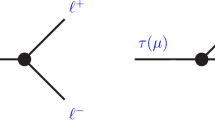Summary
From a set of lowest-order quark-loop diagrams for static mesic amplitudes involving vector and axial vector vertices, we determine the effective quark mass and the meson-quark-quark coupling constants for three types of quark models. These parameters are applied to evaluate certain mesic decays and theSU 3 mass splitting of the 0− octet and 1− nonet, which serve as tests for the quark models. Adler’s low-energy theorem for the π0 → 2γ decay is derived in our approach without invoking the Adler-Schwinger anomaly. The test favors the Nambu-Han model of integrally charged quarks. Critical examinations of the underlying assumption of the quark-loop dominance are made, and a speculation on a physical model which allows such a situation will be proposed.
Riassunto
Da una classe di diagrammi di anse di quark di minimo ordine per ampiezze mesoniche statiche che coinvolgono vertici vettoriali e vettoriali assiali, si determina la massa effettiva dei quark e le costanti di accoppiamento mesone-quark-quark per tre tipi di modelli a quark. Si applicano questi parametri per valutare alcuni decadimenti mesonici e la separazione di massa diSU 3 dell’ottetto 0− e del nonetto 1−, che servono di controlli per il modello a quark. Si deduce nel nostro approccio il teorema di bassa energia di Adler per il decadimento π0 → 2γ senza ricorrere all’anomalia di Adler-Schwinger. Il controllo favorisce il modello di Nambu-Han di quark a carica intera. Si eseguono esami critici delle ipotesi che stanno alla base del predominio delle anse di quark, e si propone di riflettere su un modello fisico che consente una tale situazione.
Реэюме
Исходя иэ системы кварковых петельных диаграмм для статических меэонных амплитуд, включаюших векторные и аксиально-векторные верщины, мы определяем зффективную массу кварка и константу свяэи меэон-кварк-кварк для трех типов кварковых моделей. Эти параметры применяются для вычисления некоторых меэонных распадов иSU 3 расшепления масс для октета 0− и нонета 1−, которые служат для проверки кварковых моделей. В нащем подходе беэ испольэования аномалии Адлера-Щвингера, выводится теорема Адлера при ниэких знергиях для распада π0 → 2γ. Проверка отдает предпочтение модели Намбу-Гана для кварков с целочисленным эарядом. Проводятся критические исследования основного предположения о доминантности кварковых петель. Обсуждается фиэическая модель, которая допускает такую ситуацию.
Similar content being viewed by others
References
D. D. Sutherland:Nucl. Phys.,2 B, 433 (1967).
S. Adler:Phys. Rev.,177, 2426 (1969);S. Adler andW. Bardeen:Phys. Rev.,182, 1517 (1969).
S. Adler:Phys. Rev.,177, 2426 (1969);J. Schwinger:Phys. Rev.,82, 664 (1951).
S. Okubo: inProceedings of the Internal Conference on Symmetries and Quark Models (Wayne State University, 1969) (New York, 1970).
J. Steinberger:Phys Rev.,76, 1180 (1949);H. Fukuda andY. Miyamoto:Progr. Theor. Phys.,4, 347 (1949).
M. L. Goldberger andS. B. Treiman:Phys. Rev.,110, 1178 (1958);111, 354 (1958).
C. H. Llewellyn Smith:Ann. of Phys.,53, 521 (1969);T. Gudehus:Phys. Rev.,184, 1788 (1969);T. Kitazoe andT. Teshima:Nuovo Cimento,57 A, 497 (1968);M. Bohm, H. Joos andM. Krammer:Nuovo Cimento,7 A, 21 (1972);Z. Maki andI. Umemura:Progr. Theor. Phys.,45, 530 (1971). Other references can be found in a review talk byG. Morpurgo:Lecture Notes at 1971 Erice Summer School.
Y. Fujii:Progr. Theor. Phys.,21, 232 (1959).
M. Y. Han andY. Nambu:Phys. Rev.,139, B 1006 (1965); see alsoN. Cabibbo, L. Maiani andG. Preparata:Phys. Lett.,25 B, 132 (1967).
We would like to stress this point in view of the recent paper byLipkin (H. J. Lipkin:Phys. Rev. Lett.,28, 63 (1972)), who argued a suppression ofC-current in deep inelastic scattering from the assumption that all low-lying hadrons are charm singlet. We can, however, expect a large charm symmetry breaking from a vector-gluon-quark interaction which involves the eighth component of a charm spin.
K. Johnson, F. E. Low andH. Suura:Phys. Rev. Lett.,18, 1224 (1967);J. D. Bjorken:Phys. Rev.,160, 1582 (1967);N. Cabibbo, L. Maiani andG. Preparata:Phys. Lett.,25 B, 31 (1967);E. S. Abers, D. A. Dicus, R. E. Norton andH. R. Quinn:Phys. Rev.,167, 1461 (1967).
J. Otakazawa andH. Suura:Phys. Rev. Lett.,21, 1295 (1968).
The ρ0-γ coupling is defined byem 2 ρ /f ρ . See, for instance,J. J. Sakurai:Currents and Mesons (Chicago, 1969), p. 65.
The value off ρ can be summarized as follows: The colliding beam data givef ρ =5.13 (±0.07) (seeS. C. C. Ting: inProceedings of the XIV International Conference on High-Energy Physics, edited byJ. Prentki andJ. Steinberger (Vienna, 1969)).
From ρ0 photoproduction it givesf ρ =5.3 (1±0.08) (H. Alvensleben, U. Becker, W. K. Bertram, M. Chen, K. J. Cohen, T. M. Knasel, R. Marshall, D. J. Quinn, M. Rohde, G. H. Sanders, H. Schubel andS. C. C. Ting:Phys. Rev. Lett.,24, 786 (1970)) andf ρ =5.55 (1±0.11) (H. J. Behrend, F. Lobkowicz, E. H. Thorndike andA. A. Wehmann:Phys. Rev. Lett.,24, 336 (1970)).
From the vector-meson universality, the ρ0 → 2π width givesf ρ =γ ρππ =5.51 (1±0.09).
A recent ρ-ω interference experiment with the colliding beam by the Orsay group gives a value forf ρ close to that determined inc). (An extensive summary for the experimental determination off ρ up to 1969 can be found inE. Lohrmann:Lund International Conference on Elementary Particles (Lund, 1969).)
See ref. (16) and especially partd).
Particle Data Group:Rev. Mod. Phys.,43, No. 2, Part 2 (1971). We used the experimental valuef π⋍93 MeV.
S. Okubo:Phys. Rev.,179, 1629 (1969); see alsoF. J. Gilman:Phys. Rev.,184, 1964 (1969).
R. H. Dalitz: inLes Houches Summer School Lecture Notes, 1969 (New York, 1970).
For example, a large quark anomalous moment was introduced in discussing ω → πγ, seeC. Bacci andG. Morpurgo:Phys. Rev.,140, B 687 (1965).
Bing-Lin Young:Phys. Rev.,161, 1615 (1967).
M. Gell-Mann, D. Sharp andW. G. Wagner:Phys. Rev. Lett.,8, 261 (1962).
J. M. Jauch andF. Rohrlich:Theory of Photons and Electrons (Reading, Mass., 1955), p. 454.
A. I. Akhiezer andV. B. Berestetskii:Quantum Electrodynamics (New York 1965), p. 631.
See, for example,R. P. Feynman:Theory of Fundamental Processes (New York, 1961).
W. Pauli andF. Villars:Rev. Mod. Phys.,21, 434 (1949).
Author information
Authors and Affiliations
Additional information
Work assisted in part by the U.S. Atomic Energy Commission.
Work performed at Ames Laboratory of the U.S. Atomic Energy Commission.
Rights and permissions
About this article
Cite this article
Suura, H., Young, BL. Quark-loop dynamics and meson decays. Nuov Cim A 11, 101–120 (1972). https://doi.org/10.1007/BF02722781
Received:
Published:
Issue Date:
DOI: https://doi.org/10.1007/BF02722781



